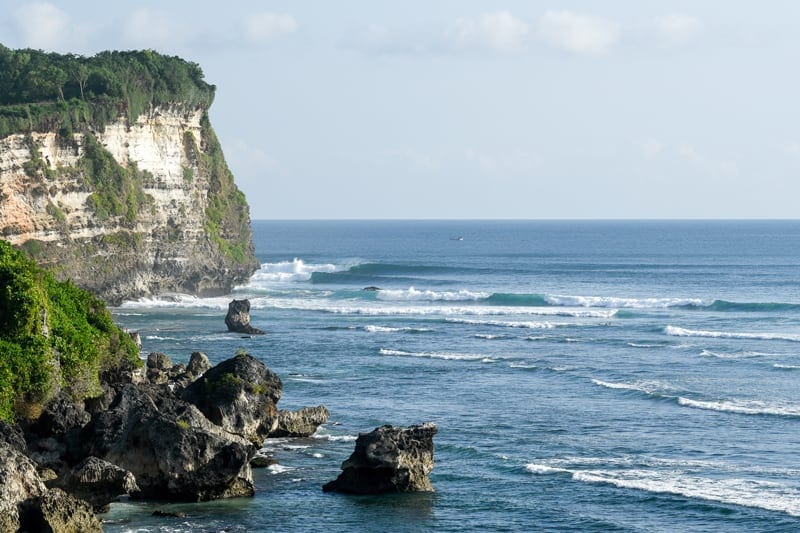
Surfing Bali is everything it’s chalked up to be and more. If you’re on the fence about a surf trip to Bali, get off that fence pronto and go. This little island in Indonesia is overflowing with natural beauty and magical vibes. And fortunately for us surfers, the waves are also pretty darn magical.
If the beauty, magic, and surf weren’t enough, the water temperature averages around 85 °F (29 °C), the Balinese are some of the most friendly people around, the food is amazing, and your money goes a long way. So yeah, Bali is a surfer’s paradise.
In this Guide to Surfing Bali, we cover everything you need to know to plan a surf trip to the Island of the Gods. When and where to go, the lowdown on the surf, places to stay, transportation, and what you can expect cost-wise, from budget to luxury.
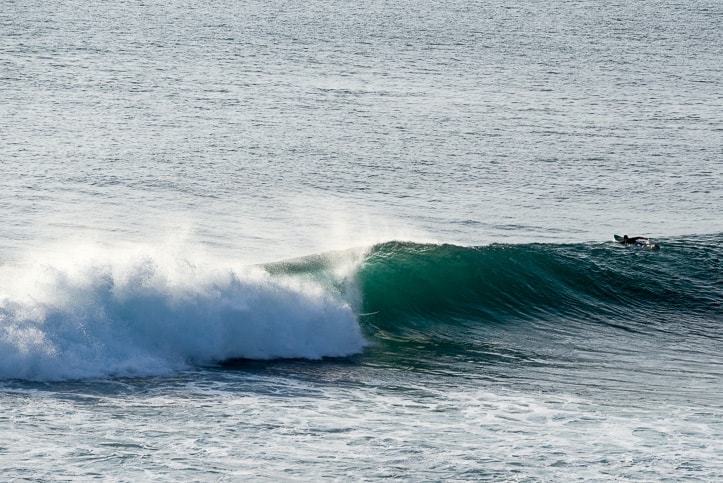
Tourism in Bali was sparked by surfing in the 1960s and the waves have continued to attract surfers from around the world ever since. Imagine how amazing it must have been to explore Bali’s breaks in the 60s (time machine, anyone?)!
Nowadays the more well-known spots can get quite crowded in the high season, but with some determination and luck, it’s possible to find yourself amongst a handful of surfers on some days.
A big bonus with surf trips in Bali is if you get some flat days on your trip there’s plenty of awesome things to do to keep you busy. Everything from exploring temples and waterfalls, to laying around gorgeous pools and beaches, to getting your party on if that’s your cup of tea.
For info on surfing other regions of Indo, check out our Guide to Surfing Indonesia >>

Surfing Bali
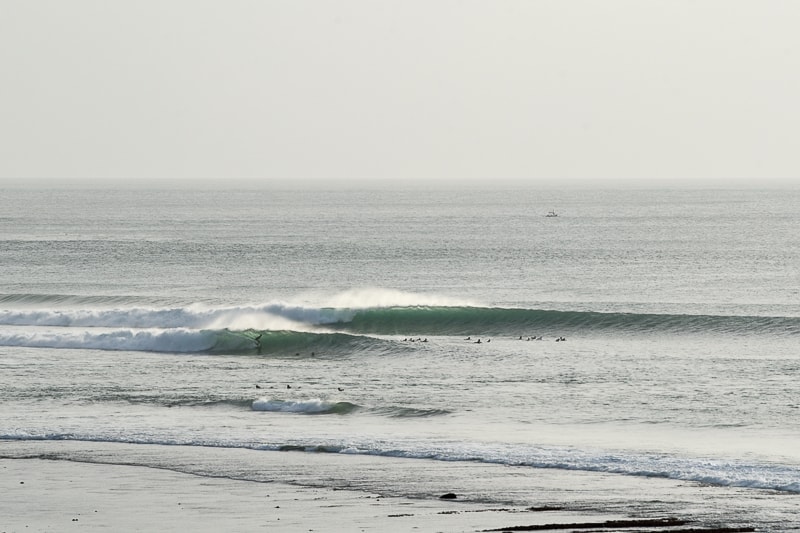
Indonesia is home to some of the best surf on the planet, and Bali is no exception. With so much surf within a relatively small area, there are almost always great waves to be found. This quote from Surfline sums it up quite nicely: “Indonesia has more islands with better surf than anywhere else on earth.” We like it.
The Bukit Peninsula in Southwest Bali has some of the best surf in Bali and its off-the-beaten-path feel is perfect for those who want to avoid the busy touristy areas of Kuta and Seminyak.
Types of Surf Breaks
World-class coral reefs, rock reefs, lava reefs, scattered beach breaks, river mouths, and points, you name it. Bali hosts a wide range of different types of surf breaks but you’ll find that reef breaks are the most common.
Level of Difficulty
Bali is known for world-class surf so it definitely attracts and is well-suited for intermediate to expert-level surfers who are seeking epic waves and are comfortable with navigating crowds. That said, there’s something for everyone and lots of people learn to surf in Bali as there are plenty of great beginner surf camps available and you can typically find beginner-friendly waves (even when it’s pumping) with the help of a local surf guide.
Season & Swell Info
The Southern Indian Ocean supplies Indo with consistent solid swells, so surf can be found year-round. That being said, the surf in Bali is relative to its wet and dry seasons. The cooler dry season from May to September is the best time for Bali’s west coast, which is jam-packed with breaks, many of them world-famous like Uluwatu and Padang Padang. From June to August, the winter in Bali brings in large swells and strong offshore winds for the west coast breaks.
The main wet season in Bali is during the summer and fall, roughly November to March, with October, April, and May considered shoulder months. During the wet season, the wind shifts to blow primarily from the west, so the east coast breaks get offshore winds and come into play. This is the time of year that east coast breaks like Keramas, Serangan, Sri Lanka and Sanur produce world-class conditions. Whereas the west coast serves up primarily lefts, the east coast is full of right-hand breaks.
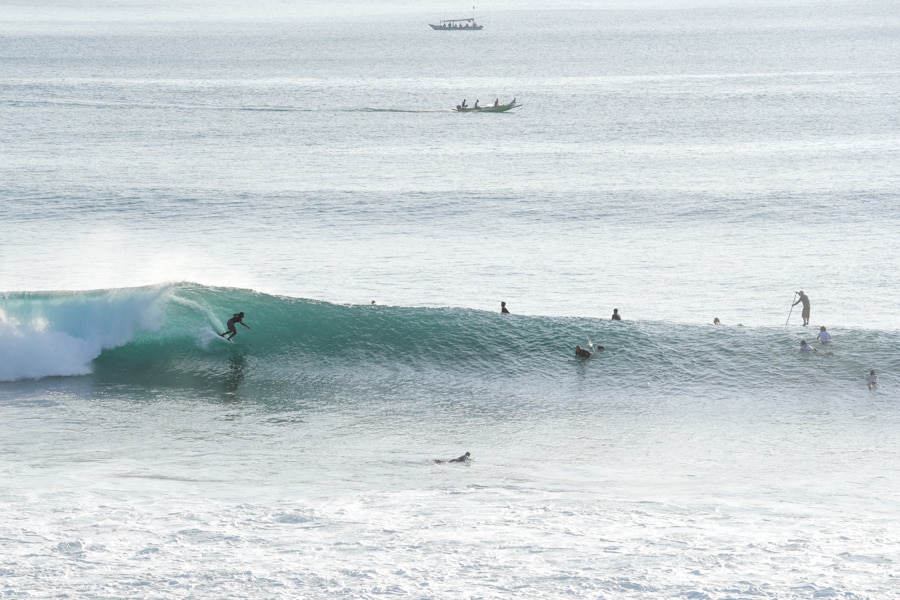
Crowds
Bali is one of the most popular surf destinations on the planet, and is often very crowded and getting more so, especially during the peak season and in the more popular areas. Many of the best waves in Bali have charter boats and surf camps keeping them plenty busy. Also, there are many expats and local rippers who have their go-to breaks on lockdown, so the competition is typically pretty stiff. That said, you can usually find windows of opportunity where you’re out with just a small group of other surfers. When surfing Bali, as always, show respect, spread friendly vibes, practice good wave etiquette and patience, and just do your best to get in the rotation.
Water Temperature
The water temperature in Bali is perfectly warm from about 80 – 84 °F (27 – 29 °C), with pretty insignificant fluctuations in temps from the wet to dry seasons. You’ll be fine in board shorts/bikinis and a rash guard if you want it most of the time. You can wear a thin 1-2mm top too if you’re surfing in the morning or want some extra protection from the sun and reefs although you might get hot if wearing a top and surfing in the middle of a hot sunny day.
Getting to the Surf
It depends on where you’re staying. We recommend picking a place with as-close-as-possible proximity to the peak you want to surf the most so you can keep a watchful eye on it and pounce when the stars align and the crowds, tides, and winds are just right. Renting a scooter is a popular way to get around and explore surf breaks in Bali, and we’ll get into more detail about transportation below in our guide. If you’re staying at a surf camp, they’ll often have transportation options for you and if you’re looking to explore nearby islands or outer reef passes then you’ll need to arrange for a boat.
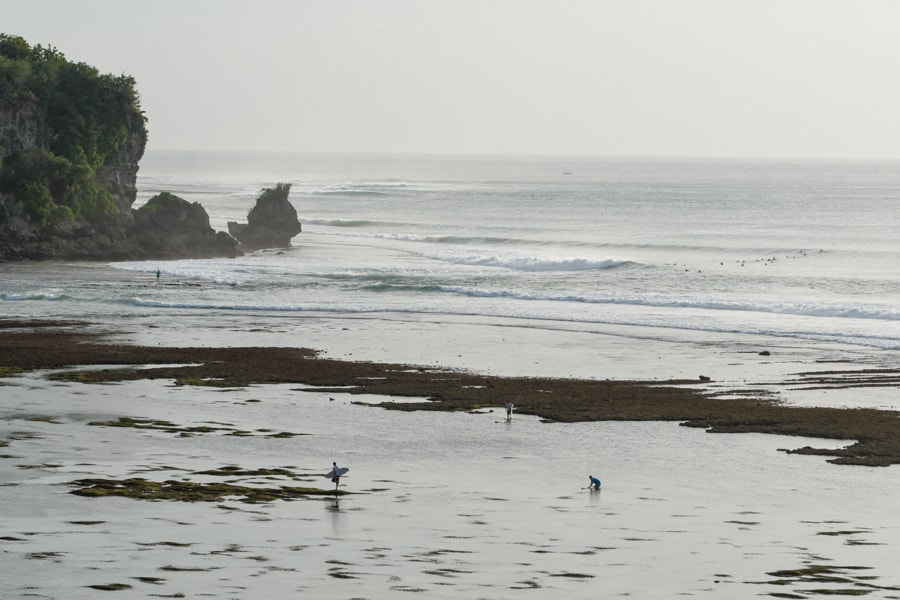
Good to Know
A Public Service Announcement on surf booties: There are a lot of reef breaks in Bali, and oftentimes you’ll have to walk across plenty of reef to get to the break. Most of the surf breaks on the Bukit Peninsula (Uluwatu area) come along with 50 – 100 meter walks across a jagged reef. Obviously, it totally depends on your comfort and tolerance for hoofing it across the sharp reef, but you might want to bring some booties along.
Bali Surf Videos
This clip features the waves of Canggu and a gang of logging extraordinaires in the Deus 9 Ft And Single, an annual just-for-fun surf contest/celebration started by Bali-based surf/motorcycle brand Deus Ex Machina.
This clip gives a taste of the waves of Padang Padang and Uluwatu with RipCurl’s Women’s Team (skip to around 4:20 for the best waves of the video at Uluwatu).
Top Bali Surf Spots
Bukit Peninsula Surf Spots
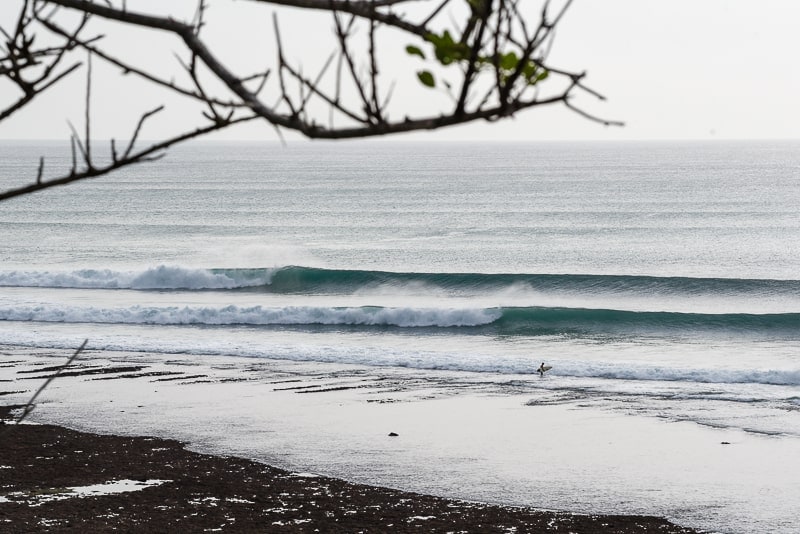
Balangan
Left-hand reef break that’s popular among intermediates and improvers on average days in the chest to head high range. The wave typically has many sections at that size but it can be plenty of fun for average surfers and some waves have better shape. More advanced surfers will enjoy plus-size days when the walls tend to line up better.
Bingin
Short left-hand reef peak that barrels like clockwork with the right tide and swell. The takeoff zone is pretty compact so you need to be comfortable in a crowded and tight lineup to get any waves. Be sure to kick out in time before the reef goes dry on the inside end section.
Impossibles
Within eyesight from Bingin, Impossibles is a left reef break that got its name from having fast racey sections in the reef that are often impossible to make. But on a decent long period south swell and low-to-mid tide it can get very fun and rippable.
Uluwatu
Uluwatu is actually a cluster of 6 different left-hand reef breaks on the southwest tip of the Bukit Peninsula. From the far left point to the right you’ll find Secrets, Temples, Bombie, Peak, Outside Corner, and The Racetrack. You can check out our full Guide to Surfing Uluwatu for more details on each of the peaks. But in summary, it’s an epic cluster of punchy and hollow reef breaks, and one of the premier surf spots in Bali.
Green Bowl (AKA Green Ball)
On the south side of the Bukit Peninsula, Green Ball is a right-hand reef break that requires a bit of a trek down a few hundred stairs. The break is known for having strong currents but that’s mostly on the bigger swells with more energy in the water. The right is the main attraction with sometimes crumbly or hollow sections depending on the tide and size. Head high and mid-tide is a good time to go. Wind is the enemy so try to get on it early.
West Side Surf Spots
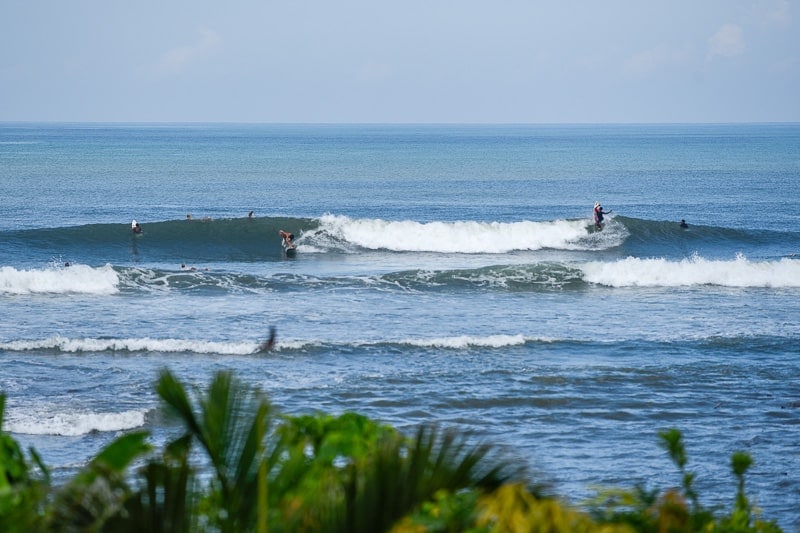
Canggu
Black sand beaches, a variety of beach break peaks typically best in the head high to slightly overhead range with some patches of reef and a river mouth to the north end of the beach toward Perenenan with both lefts and rights. Can be tide sensitive with a mid-tide typically being the best and some punchy and hollow sections up for grabs.
Old Man’s
On the south side of the town. A longboard-friendly stretch of cruisey rights and lefts along a reef that attracts all sorts of wave-riders and is a popular hangout for everyone.
Balian
A fun-for-all-levels rocky river mouth break that can hold some decent swell well overhead. Not as powerful as the reefs of Uluwatu but rippable and user-friendly with the occasional inside barrel. Picks up lots of swell and offers both lefts and rights with the left being the main attraction.
Medewi
About an hour or so north of Balian, Medewi is a fun, long, and mellow sand bottom cobblestone left hand point break. When the swell angle is the right mix of south-southwest the wave can connect and run for several hundred yards.
East Side Surf Spots
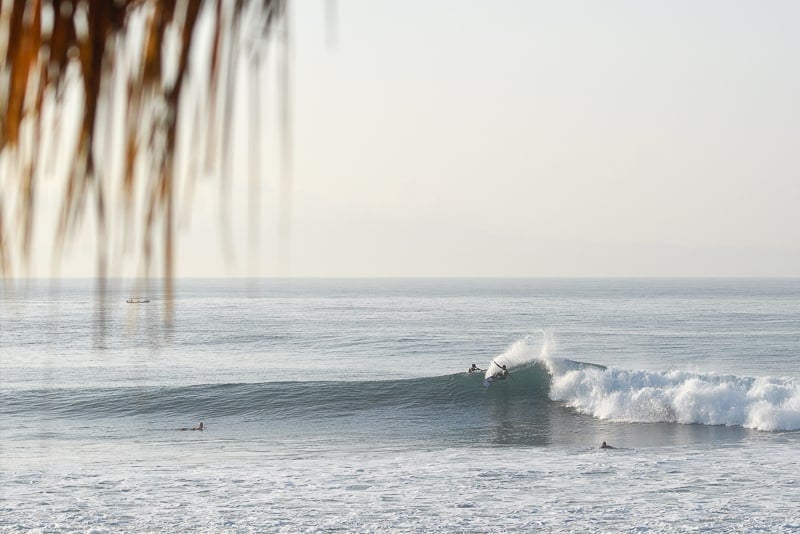
Keramas
One of the crown jewels of the East Coast of Bali. Keramas has made appearances as a stop on the World Surf League Championship Tour. The wave is a powerful right-hander with heavy lips, hollow barrel sections, and is typically better suited for more advanced surfers.
Sanur
An expert only hollow and dredging right hander over shallow reef. Critical and challenging wave that needs a solid swell to come to life and is known to have a bit of localism so mind your p’s and q’s.
Serangan (Turtle Island):
A-frame peaks (rights and lefts) that break over coral reefs with rippable and sometimes hollow sections on offer depending on the tide swell size. Breaks on all tides. Is a very popular spot during the wet season from October to April. Located right in front of a rock jetty.
For info on surfing other parts of Indo, check out our Guide to Surfing Indonesia >>
Surf Trip Costs in Bali & Travel Seasons
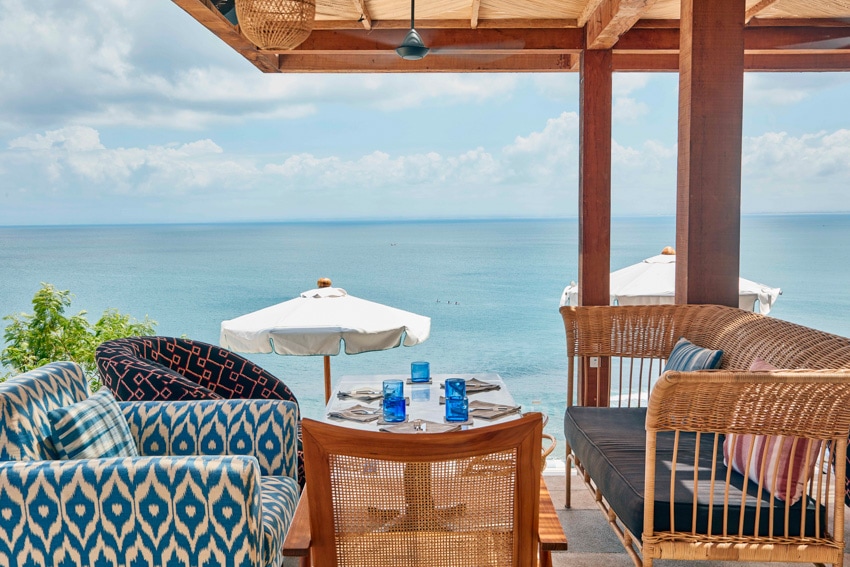
As with any travel, the cost of your surf trip will vary depending on what time of year you go, where you stay, how many people you’re traveling with, and your overall travel style. The good news is that whether you’re on a tight budget or livin’ large, your money will go a long way in Bali. That being said, the best time to visit Bali is outside of the high season, as the prices and crowds exponentially rise.
Below we’ve listed general ranges of surf trip costs at different price points to give you an idea of pricing, as well as some insights into Bali’s travel seasons and how they can affect the costs of your trip. (Prices are in USD and based on costs per person)
- Budget: $40 – $100 per day
- Mid-Range: $100 – $200 per day
- Luxury: $200 – $400+ per day

Bali Travel Seasons
Low Season
Low season in Bali can be found at two different times of the year: January to April, and October through November. Like most low seasons, there are discounts everywhere and you can find good deals on airfare. The low season coincides with Bali’s rainy season, but rainfall isn’t excessive so you’re still able to do most activities.
Shoulder Season
Shoulder season in Bali is May, June, and September. These shoulder months are an ideal time to visit Bali because it’s dry season (less rain and humidity) and a great time for surf, but you’re avoiding the crowds and prices of high season. During shoulder season you can find some reduced rates and can book places to stay and activities more spontaneously than high season.
High Season
High season in Bali is July and August, and also around Christmas and New Year. During the high season rates increase by 50% or more, and many hotels and restaurants need to be booked far in advance. It goes without saying that there are more crowds and traffic than any other time of year, and it’s generally best to avoid this time of year, if possible.
Bali Travel Basics
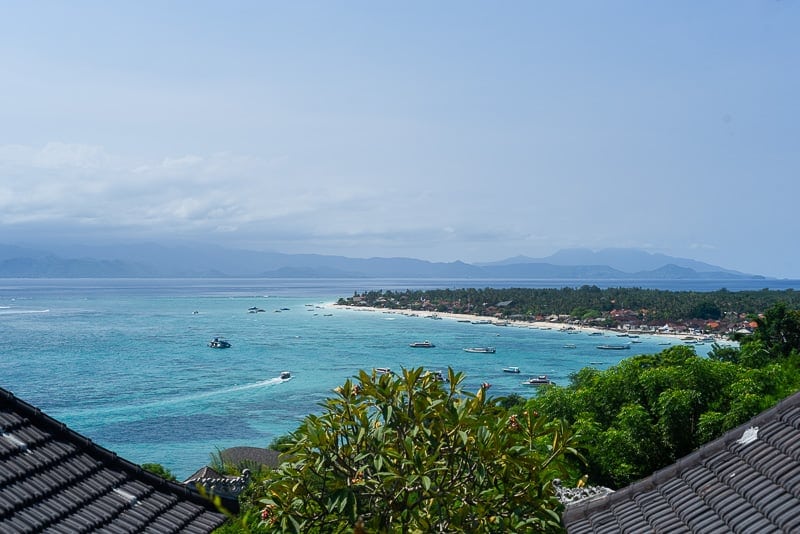
Location
Bali is an island and province in Indonesia. Approximately 8 degrees south of the equator, the province includes the island of Bali and a few smaller neighboring islands (notably Nusa Penida, Nusa Lembongan, and Nusa Ceningan).
Weather
Bali has a fairly consistent tropical, warm, and humid climate year round. Average year-round temperature is around 86 °F (30 °C) with a humidity level of about 85%. Bali has two main distinctive seasons: the dry season (April – September) and the rainy season (October – March).
Money
Indonesian Rupiah (IDR) is the currency of Bali (and all Indonesia). At the time of writing, 1 USD = 13,300 IDR / 1 AUD = 9,800 IDR / 1 EURO = 14,600 IDR
Tipping
Not expected or encouraged, though it is acceptable for outstanding service at nicer restaurants. Some more upscale restaurants add a non-negotiable tip to your final bill which can range from 5% to 10% (these added tips are always disclosed on the menu).
Staying Connected
For a developing island, Bali has pretty good internet overall due to the tourism industry. Generally, mid to high range accommodations will have faster, better internet, but even budget accommodations will usually have decent wifi. Apparently, restaurants and cafes have seen the benefits of offering free wifi because almost every place will advertise “free wifi” (besides small local warungs).
As with anywhere, the more rural you travel, the less internet access you’ll find, but you should still be able to find decent wifi in rural Bali. If you want to have data for your phone, pick up a SIM card at the airport or in a store. Telkomsel is a large Indonesian phone company with good coverage.
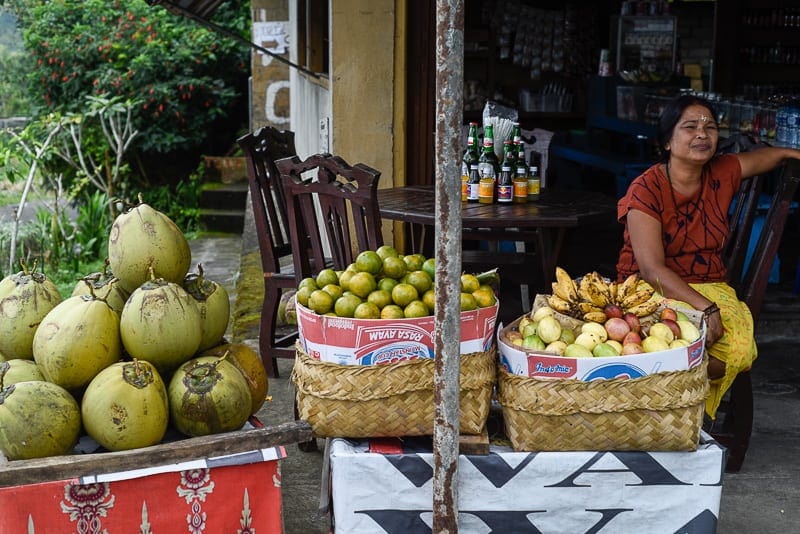
Language
Bahasa Indonesia and Balinese. Indonesian (AKA Bahasa Indonesia) is the official language of Indonesia and the language used in most government, mass media, etc in Bali. In addition to speaking Indonesian, most Indonesians are fluent in one or more than 700 indigenous local languages (examples include Balinese, Javanese, and Sundanese). Most Balinese are bilingual if not trilingual (Indonesian, Balinese, English). Many Balinese people in the tourism industry will speak some English, but English can fairly limited in more remote areas. Here are a few Bahasa Indonesian words to get you started
- Good morning: Selamat pagi (s’lah-mawt pag-jee)
- Good day: Selamat siang (s’lah-mawt see-ung)
- Good afternoon: Selamat sore (s’lah-mawt sore-eh)
- Good night: Selamat malam (s’lah-mawt maw-lahm)
- Please (can I have?) = Minta (min-tah)
- Please (help me) = Tolong (toe-long)
- Thank you: Terima Kasih (teh-ree-mah kah-see)
- You’re welcome: Sama Sama (saw-ma saw-ma)
Water
Tap water in Bali is not drinkable. Always drink bottled water, and we recommend brushing your teeth using bottled water as well to avoid the dreaded Bali belly.
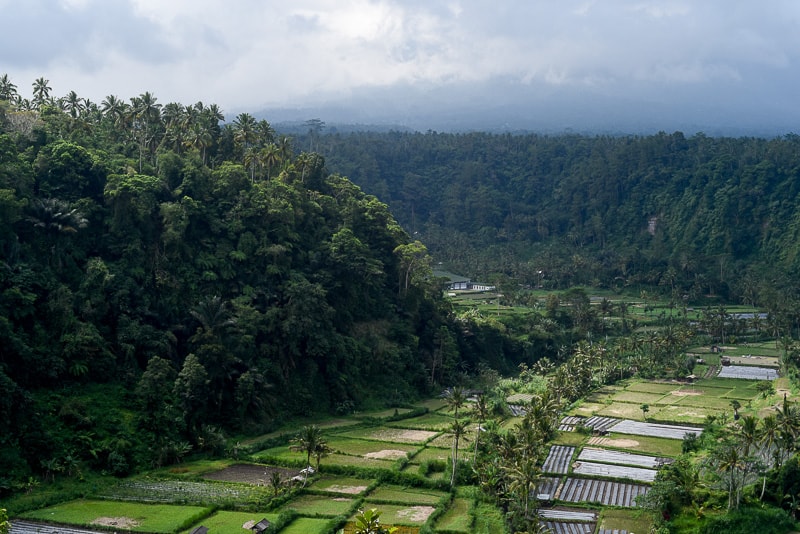
Good to Know
Here’s some etiquette in Bali that’s helpful to practice during your trip:
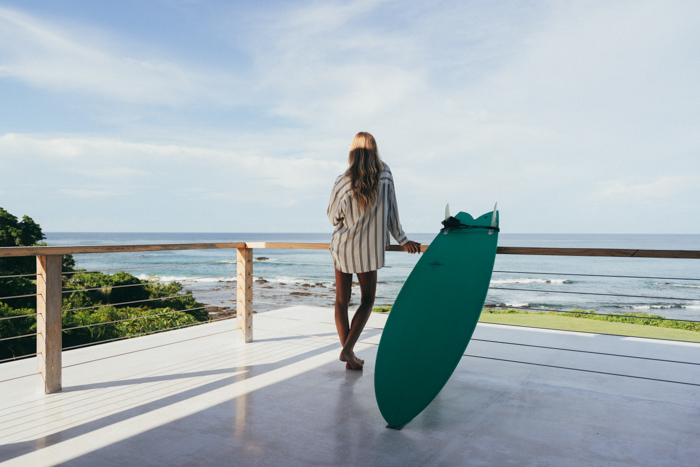
Epic surf trips made easy.
Explore luxury done-for-you surf vacations with Lush Palm Private Retreats.
- Don’t use your left hand to shake hands, touch, or give. This has to do with the left hand being used for hygienic purposes. Balinese traditionally don’t use toilet paper (they use water), and the left hand is reserved for bathroom duties. Therefore, the left hand is considered somewhat dirty, and should never be used to touch other people or to hand something over.
- Dress and act modestly. This doesn’t mean you need to cover up entirely or cut out all PDA, it’s just good to be aware that Balinese people are more conservative than Westerners, and frown on public displays of affection. In more touristed areas it’s pretty relaxed, just be especially considerate near temples or in rural parts of Bali.
- Temple etiquette. When visiting a Balinese temple, both women and men should wear shirts that cover shoulders and part of the upper arms. And special leg coverings are mandatory. Both women and men must wear a sarong (kain kamben) around your legs, and a temple scarf (selendang) around your waist. Feel free to bring your own, but at most temple entrances you can rent both items for use during your visit.
Where to Stay in Bali
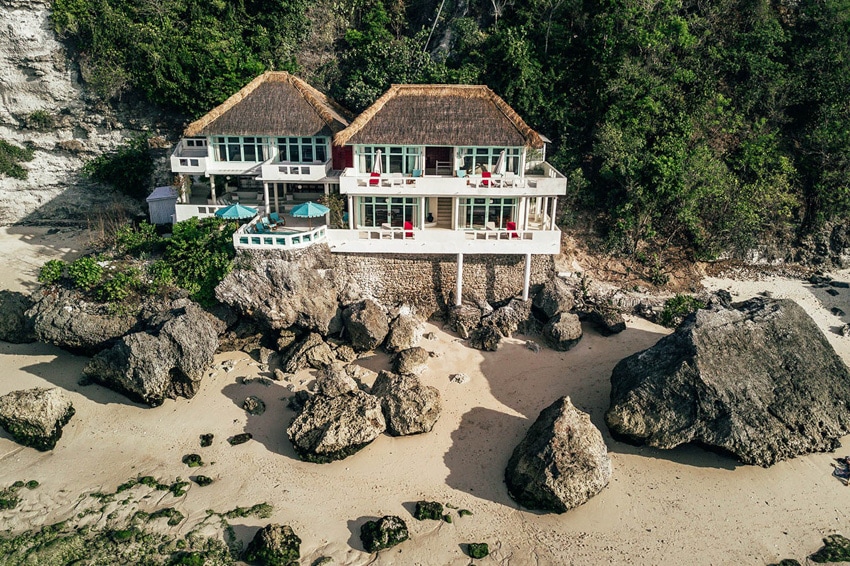
Bali is full of seriously gorgeous places to stay and rates are incredibly reasonable. For example, we’ve scored over-the-top five-star hotels for $180 a night (including breakfast), whereas the same type of hotel could cost upwards of $500 in the United States. Heck, you can barely get a three-star hotel in some US cities for $180.
Whatever your budget, there are lots of really awesome places to stay in Bali. There are also some good options for surf camps and getaways specifically tailored to surfers. Many surf trip packages include accommodations, meals, surf lessons, and transport to the breaks.
If you’re tight on cash, Bali offers plenty of lodging options under $50 per night. Whereas in many surf destinations you’d be looking at hostels in this price range, in Bali you can get a decent, if not lovely, private room or small villa (depending on the time of year). Obviously, sharing a room or villa with a travel companion or two makes this even more economical.
A couple of the most popular areas for surfing Bali are Canggu and the Uluwatu area on the Bukit Peninsula. That said, there’s great surf to be found in many other parts of the island like the East side (Keramas/Sanur area), Balian, Medewi, and the nearby island of Nusa Lembongan.
Below are some of our top recommendations for where to stay in Bali for surfing, and this will also give you an idea of the type of accommodations you can expect at different price ranges. These properties were all hand-picked based on design, amenities, reviews, and proximity to surf breaks.
BUDGET • up to $50 per night

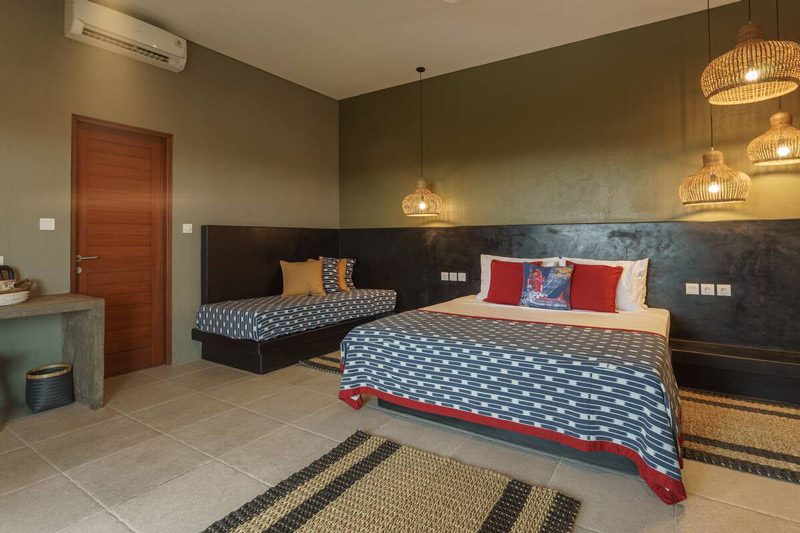
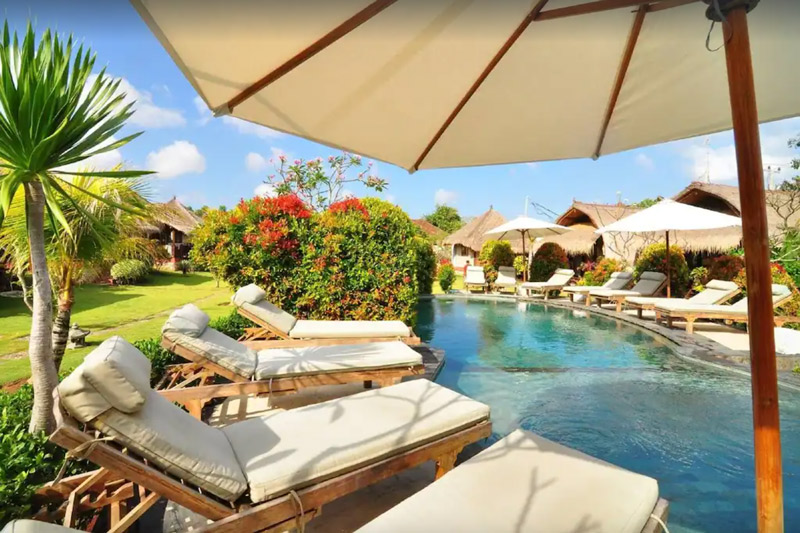
MID-RANGE • $50 – $200 per night
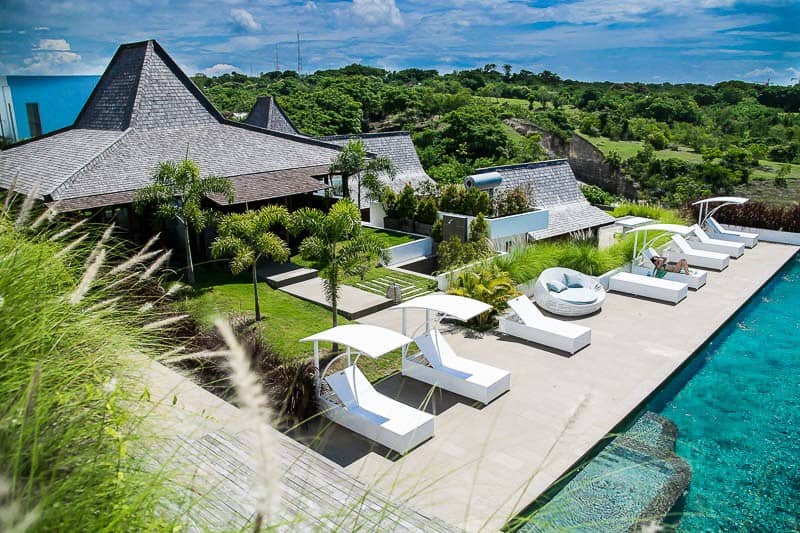
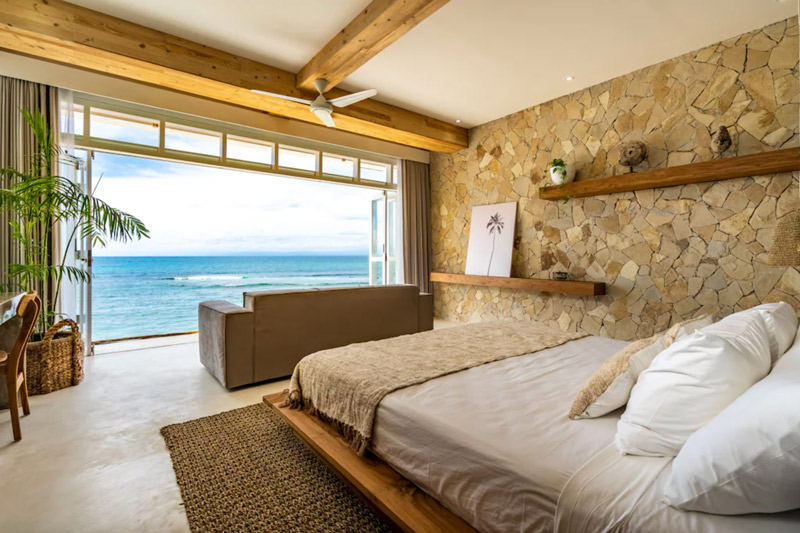
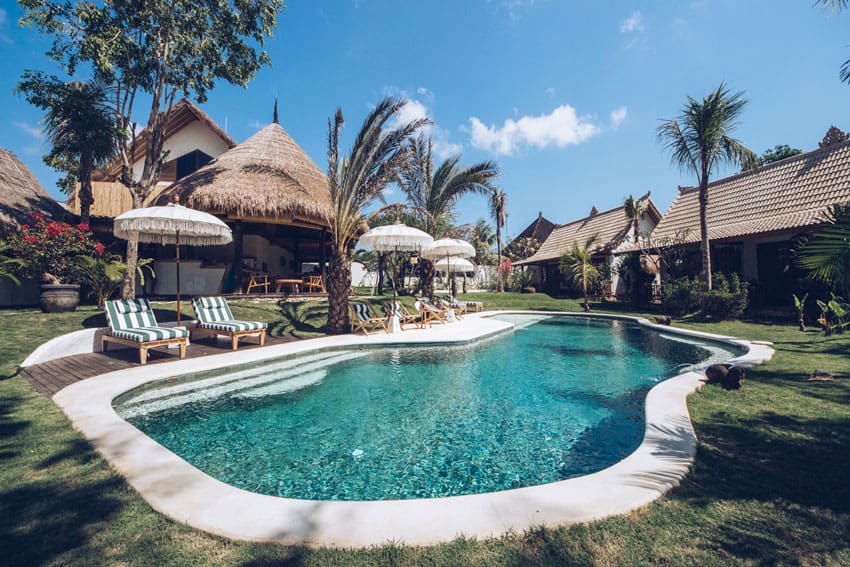
LUXURY • $200+ per night

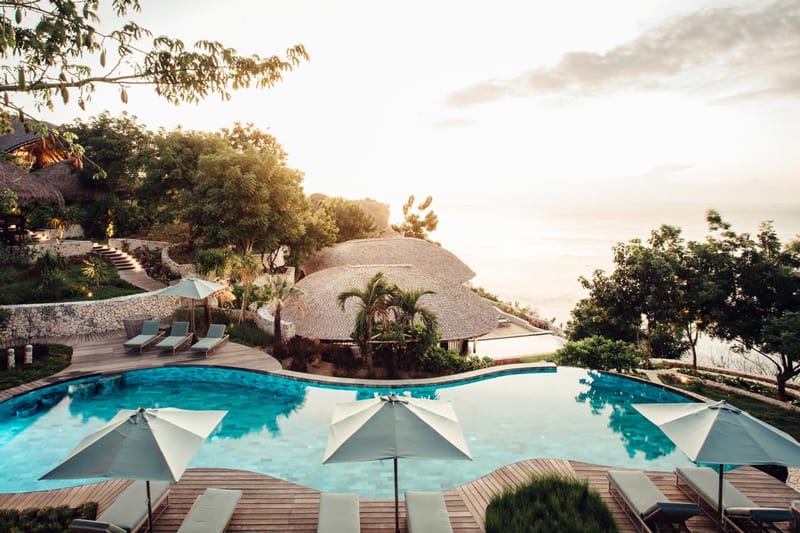
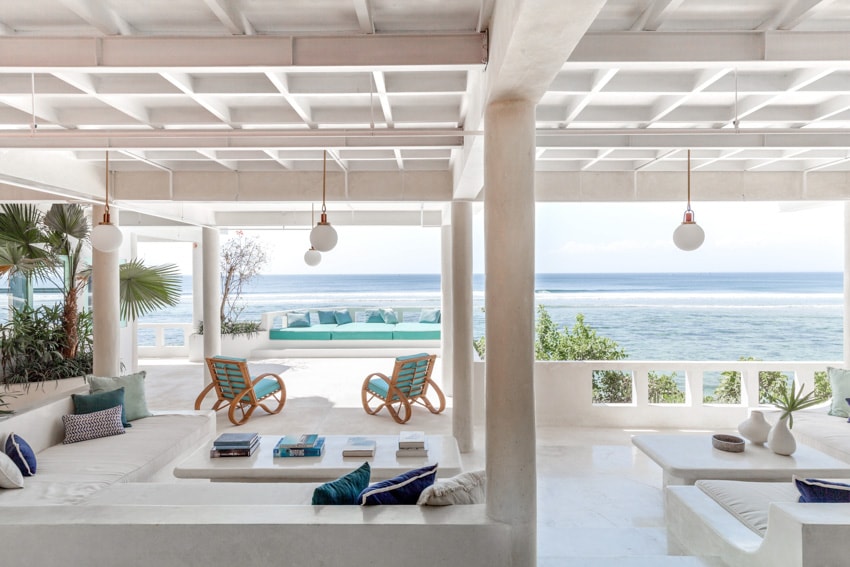
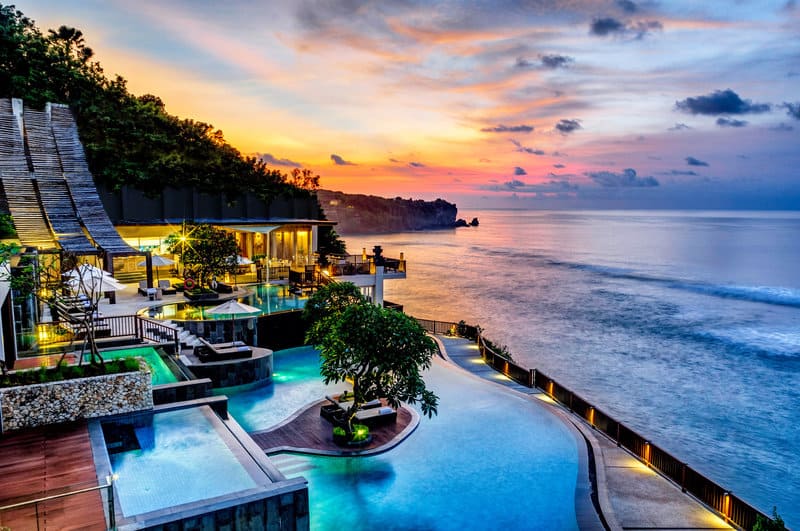
Eat & Drink

It doesn’t matter if it’s a $3 plate of mie goreng (fried noodle dish), or a $15 plate of fresh seafood, it’s rare to encounter a bad or even mediocre meal in Bali (unless you have a knack for picking terrible tourist traps). We’re serious foodies, so when we say there’s a lot of great food in Bali, you best believe there is a lot of great food in Bali.
Bali is a food lover’s paradise, especially if you like it spicy! Just the thought of Indonesian food makes me go into a Homer-Simpson-donut-loving food trance. Mmmm. In case I didn’t make my point, Indonesian food is insanely delicious! Fragrant spices, exotic island ingredients, and slow cooking techniques majorly pack some punch in the flavor department.
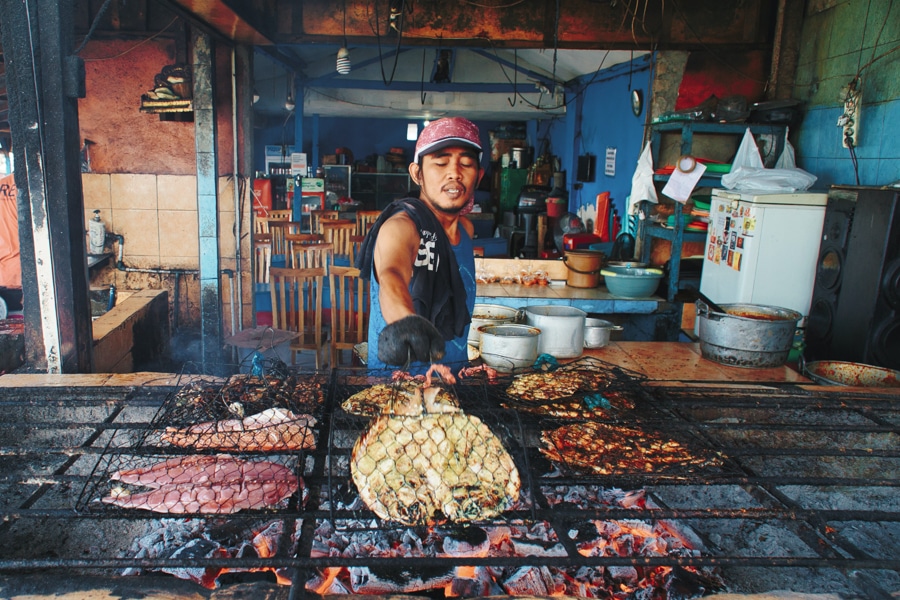
There’s plenty of options for meat eaters and vegetarians alike. For meat eaters, you’ll definitely want to try some local specialties like Babi Guling (slow-roasted sucking pig), sate (marinated and skewered grilled meats), Bebek Betutu (slow-cooked duck), and fresh seafood dishes.
For vegans and vegetarians, you’ll find heaps of fantastic vegan and vegetarian options all over the island. As you can imagine, fresh tropical fruits and vegetables make for some mean vegan delights. Many restaurants offer tofu and tempe along with plenty of vegetable, rice, and noodle dishes to choose from.
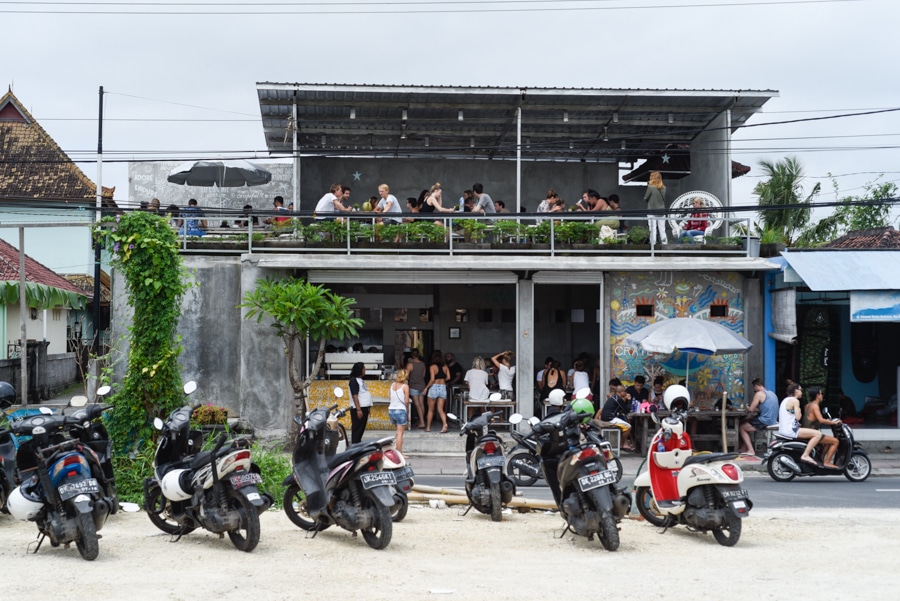
If you’re not into Indonesian food for some (crazy!) reason, there’s every other type of cuisine available, from Italian to Mexican to Californian if you so desire. Canggu, the Uluwatu area, and Ubud all have a growing roster of impressive restaurants with top-notch food and design to choose from.

- COST: As with everything else, there’s a wide range of food costs in Bali. Overall, your money will go a long way. At warungs (local Balinese restaurants), you can spend around $5 for a meal. If you’re on a budget and stick to cooking and eating at local places you could spend as little as $15 a day or less on food. As mentioned (repeatedly), there are fantastic restaurants all over the island, so we highly recommend indulging.
Transportation
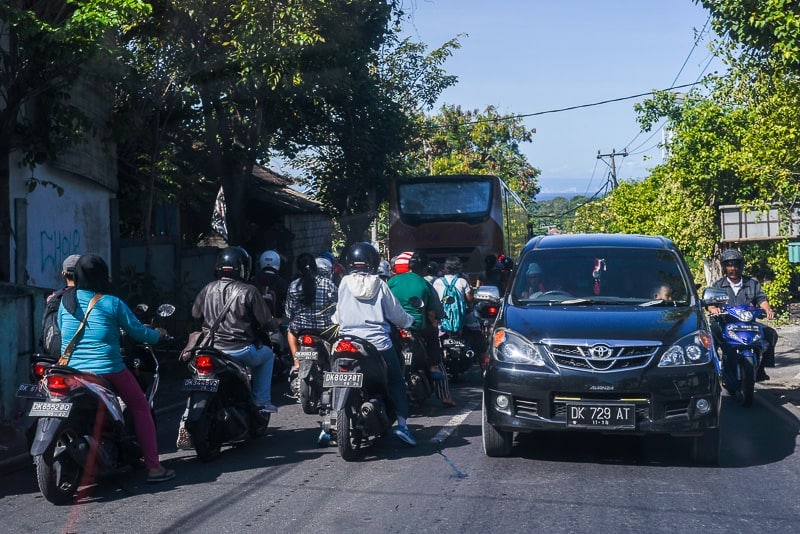
Transportation in Bali is straightforward, as there aren’t a lot of options. The good news is that you don’t need a lot of options because the ones available are both easy and a good value, especially if you’re traveling with two or more people. Basically, you can hire a driver or rent a scooter, and we’ll go into details about those options below.
Depending on where you’re traveling from, your flight might end up being your largest cost for your whole trip. We’ve listed out some sample flight costs below.
Flight Costs
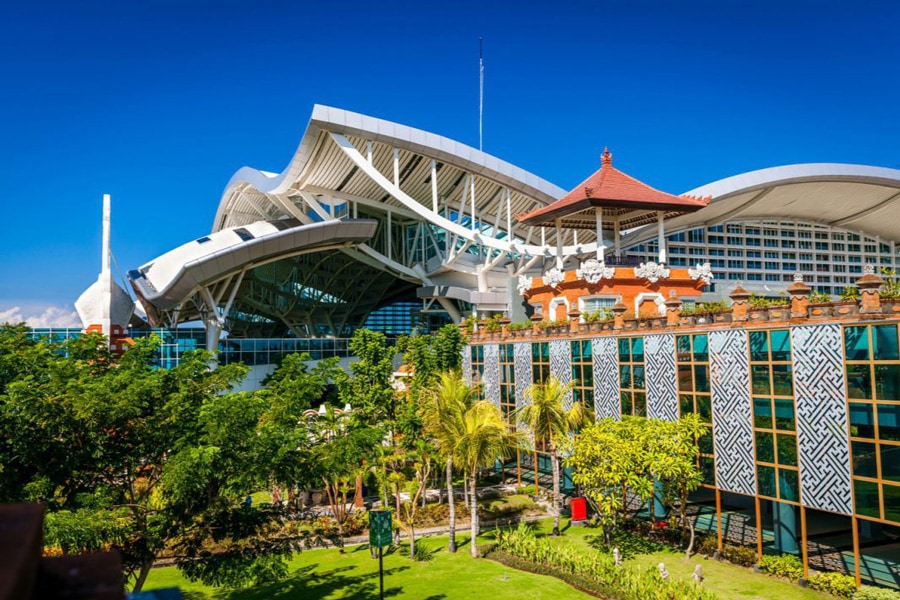
If you live in Australia or New Zealand, you probably know that you can score great fares to Bali. If you live in the United States or Europe, the single biggest cost of your trip could very well be your flight.
The main airport in Bali is Ngurah Rai International Airport (DPS), also known as Denpasar International Airport, which is located in southern Bali, 13 kilometers south of Denpasar. Lucky for us, the Denpasar Airport got a lovely makeover in 2014, and it’s now rated one of the best airports in the world.
To give you an idea of airfare costs to Bali, we rounded up typical airfare ranges from a handful of major cities below. All flight prices are roundtrip including taxes, and shown in US dollars.
LAX > Denpasar:
- good deal: $700
- average: $1,200
NYC >Denpasar:
- good deal: $830
- average: $1,300
Miami > Denpasar:
- good deal: $1,350
- average: $1,700
London >Denpasar:
- good deal: $760
- average: $900
Sydney >Denpasar:
- good deal: $430
- average: $600
Surfboard Bag Fees
Unless you fly on one of the few airlines that don’t charge for surfboard bags, tack on an additional $75 – $200 each way if you want to bring some boards. Check out our guide to surfboard bag fees for the lowdown on the best and worst airlines for board bag fees.
How to Get Around in Bali
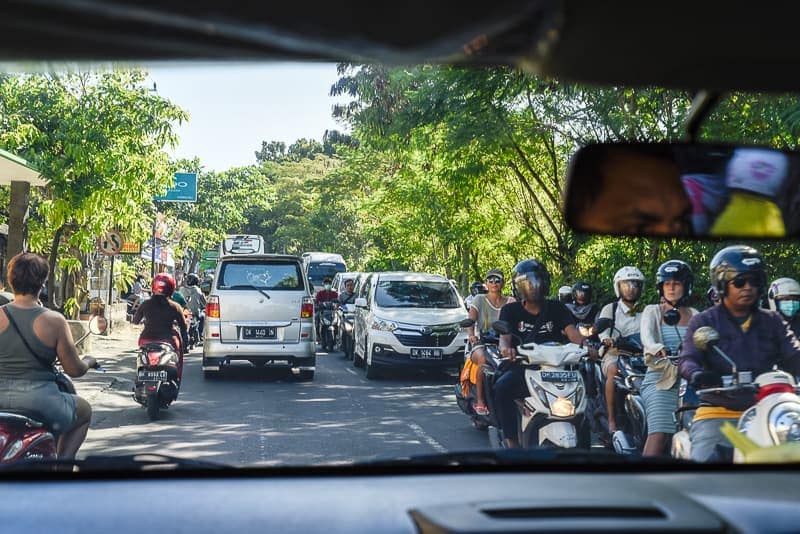
Hiring a Driver
When you’re traveling long distances (40 minutes+), the best way to get around is hiring a driver. If you’re new to the idea it might sound like an expensive option, but hiring a driver/car in Bali is actually a relatively budget-friendly way to get around and by far the safest. I’ll explain.
Driving in Bali is a crazy mad dash of disorganized chaos. Motorbikes weave in and out of traffic, people barely pay attention to what few traffic signs there are, and it’s pretty much a total free-for-all.
It’s literally a complete wonder there aren’t constant pile-ups and accidents all over the place. So with that being said, drivers in Bali are used to this chaos and navigate it well, whereas we non-locals would have an extremely hard time driving. Just take my word for it and do yourself a favor–hire drivers to get around.
- COST: $30 – $50 (400,000 – 600,000 Rp) to hire a driver for a full day.
- Point-to-point destinations are of course much less.
Tips on Hiring a Driver in Bali
- If possible, ask the place you’re staying if they know a driver or can call one. Another great option is to ask other travelers for recommendations (many drivers have business cards they give out to passengers).
- We know a wonderful driver in Bali who was actually recommended to us before our trip. If you email us we’re happy to give you his info!
- In busier tourist areas drivers will be waving around signs that say “transport.”
- Discuss and agree on a route, itinerary, and pricing beforehand.
- If you’ve hired the driver for the day, they’ll ask you where you want to go, and good drivers will make recommendations. Some great drivers will take the role of a tour guide and can really make your day. Remember to tip them for great service.
- If you’ve hired a driver for the day, buy the driver lunch and offer drinks and snacks.
Renting a Scooter
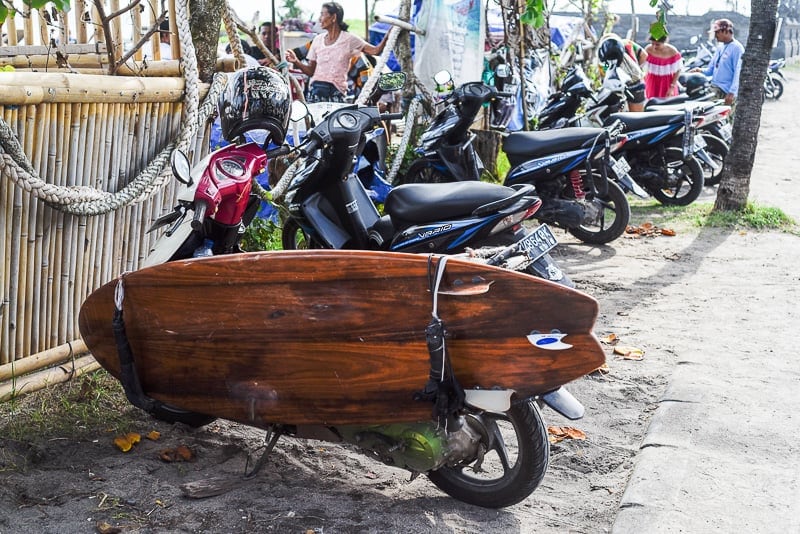
Another popular option for getting around in Bali is renting a scooter, and surfboard racks are also readily available. Scooter rentals are pretty cheap and convenient but beware of some caveats. As mentioned, driving in Bali is dangerous and chaotic as-is, so driving a scooter is about 50 times worse. This isn’t an exaggeration. Visitors get into serious motorcycle accidents on a daily basis, some of which are fatal.
That said, if you’re a decent driver and comfortable driving a scooter, you should be fine. When renting a scooter it’s ideal to stick to one general area and not venture on long trips or into heavily trafficked busier parts of the island. The best circumstances for scooters are when you stay in the more rural areas. For example, venturing around the Bukit Peninsula, there is plenty of open road, and not a lot of traffic. You can scooter around from one surf spot to the next without issue, and it can be an easy and lovely way to explore the area.
- COST: $7-10 (90,000 – 130,000 Rp) per day for a scooter with a surfboard rack.
Scooter Tip
Never cruise around holding an iPhone, or other expensive tech, and also never have a shoulder bag or purse hanging off your side. It’s important to always store valuables in the compartment under the seat. There is relatively low crime in Bali, but unfortunately, petty theft still happens, so definitely always be aware. Carting around valuables within easy snatching distance is an easy target for thieves, and sadly, tourists have been pulled off their scooters by bag snatchers.
In one situation, two young female travelers were killed when a bag was snatched off one of them while they were driving. And we spoke with one woman who was on a scooter holding an iPhone (as the passenger) and someone came by on a scooter, grabbed her iPhone right out of her hand and took off with it. Not to be all doom and gloom — just know the risks, be aware, and be street smart!
Boats & Ferries

To get to the islands off of Bali, you can either fly or go by boat. Ferries can be extremely slow, so definitely opt for a fast boat when possible. There are many fast boats operating between Bali, Nusa Lembongan, Lombok, and the Gili islands.
Padang Bai > Lombok or Gili Islands
- COST: $83 round trip (1.08M Rp) via Gilicat
Sanur > Nusa Lembongan
- COST: $46 round trip (600,000 Rp) via Scoot Fast Cruises
Sanur > Gili Islands or Senggigi Lombok
- COST: $90 round trip (1.2M Rp) with Bali Brio
Surfboard Rentals
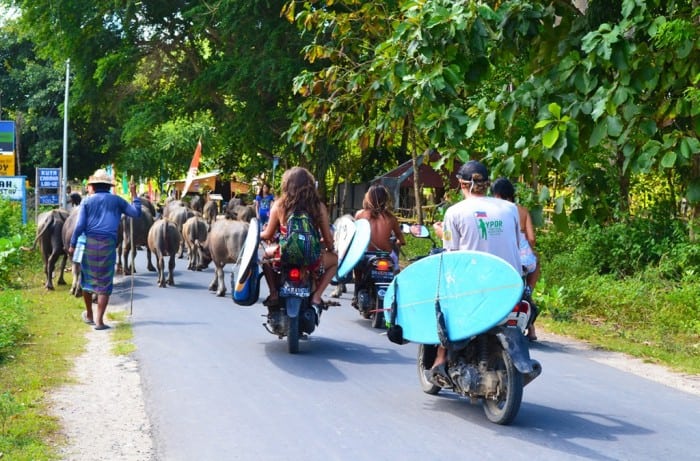
If you’re a beginner, definitely don’t bring a surfboard with you, as many surf schools and lessons will include board rental. And even if you’re not taking lessons there’s plenty of boards you can rent hourly or daily.
If you’re an intermediate to advanced shredder, there’s obvious pros and cons to taking boards. Cons being that you have to pay airline surfboard bag fees, risk board damage, and lug your boards around. The pros are that you’re all set with your ideal boards and you don’t have to hassle with searching for the right board to rent.
The more tourist-heavy areas like Kuta and Seminyak will have the most options for surfboard rentals, but in quieter areas like on the Bukit Peninsula (Uluwatu area), there can be slim pickings rental-wise.
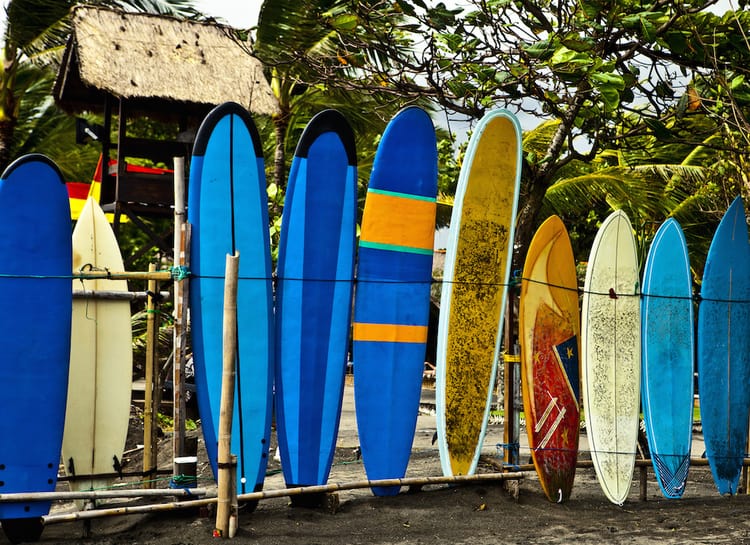
It can be challenging to find good rentals in the Uluwatu area because there are a lot of funky damaged boards (not shocking with that reef), or a few shops have newer boards you can demo for a pretty penny. At many of the breaks, there are shops or warungs that have boards for rent, you just have to ask around.
The other thing is that if you rent by the breaks, the vendors typically don’t rent out on a daily basis, so you can only rent by the hour and then you’re board-less again for your next session which can be inconvenient. Generally, it’s cheaper to rent a board in town that you can rent by the day, but again there could be fewer options.
The cost of surfboard rentals ranges depending on how long you’re renting for, but generally, expect to pay from $4 to $15 per session, or $8 to $20 per day. Most of the time, the pricing is negotiable, so if you want to save some dough you’ll want to sharpen those haggling skills. You can read more about board rentals in our article on tips for surfing Uluwatu.
All things considered, if you’re an intermediate to advanced surfer, we highly recommend bringing boards on your trip. Alternatively, there are some awesome shapers in Bali, so you could buy a board in Bali and bring it home with you.
Surf Lessons in Bali
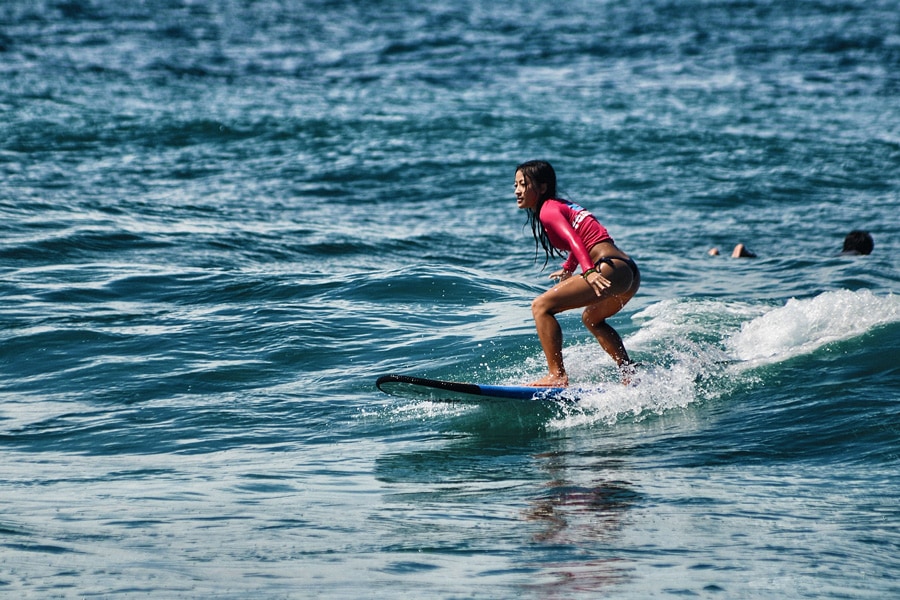
With Bali’s reputation as a surf destination, there are plenty of options for surf lessons, especially around Kuta, Seminyak, and Canggu. Of course, conditions change on a daily basis, but typically the breaks on the Bukit Peninsula and Nusa Lembongan are best suited for higher-level intermediate to expert surfers.
Surf lessons vary in cost depending on the number of people in the lesson, the number of lessons purchased, length of the lesson, and what’s all included (transportation, etc). Generally, surf lessons in Bali will range from $12 – $50 per lesson, per person.
If you’re interested in learning how to surf, a surf camp is an awesome way to get lessons every day and build a solid foundation with good instructors before continuing your surf progression on your own. There are some great budget-friendly surf camps in Bali that offer accommodation and lessons. One of our top recommendations for surf camps is Rapture Bali.
Surf Charters
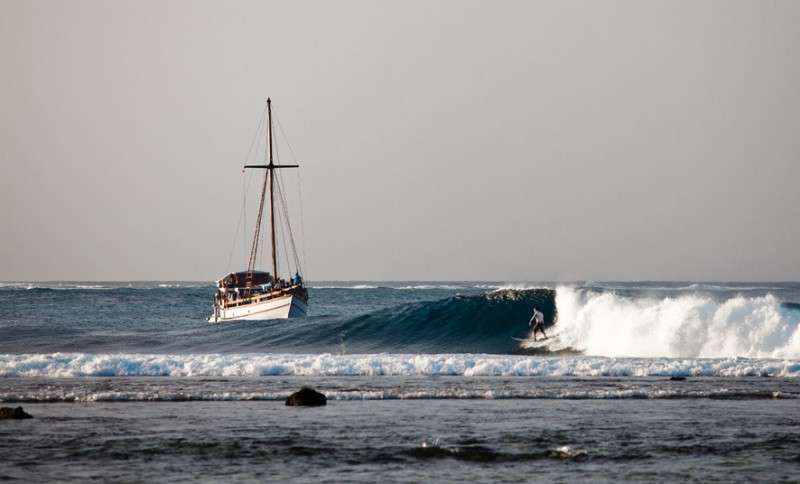
Surfing Bali via a surf charter comes in many different forms. Surf charters vary from 1 – 2 week voyages to 1 – 2 day trips, to several hours depending on what you’re looking for.
Here are a few examples of pricing on surf charters in Bali (all pricing is in US dollars):
- Dreamweaver Surf Charters
- 7 days/7 nights:
- Peak Season (April – September): $1,140 per person
- Low Season (October to the end of March): $990 per person
- 7 days/7 nights:
- Bali Surf Charters
- 7 days/6 nights
- starting at $950 per person
- 2 day/ 1 night
- $135 per person
- 7 days/6 nights
- Bali Surf Express
- Full day (8 hours):
- $95 – $120 per person (includes hotel/villa transfer)
- Full day (8 hours):
Travel Insurance
While we’d all rather not think about getting injured, there are too many cases of people who didn’t think about insurance and get nailed with crazy medical bills after the matter.
That being the case, many hotels and surf properties actually require that you have approved travel insurance in case of a serious inquiry or trip cancellation, especially in the wake of COVID.
You know the deal—better safe than sorry. Here are a couple of companies that offer travel insurance for adventure trips; battleface and World Nomads Insurance. Both companies offer very comprehensive travel insurance and cover heaps of activities, including surfing and ocean sports. You can easily check them out and get a fast quote below.
Get a battleface Insurance Quote >>
Get a World Nomads Insurance Quote >>
Frequently Asked Questions
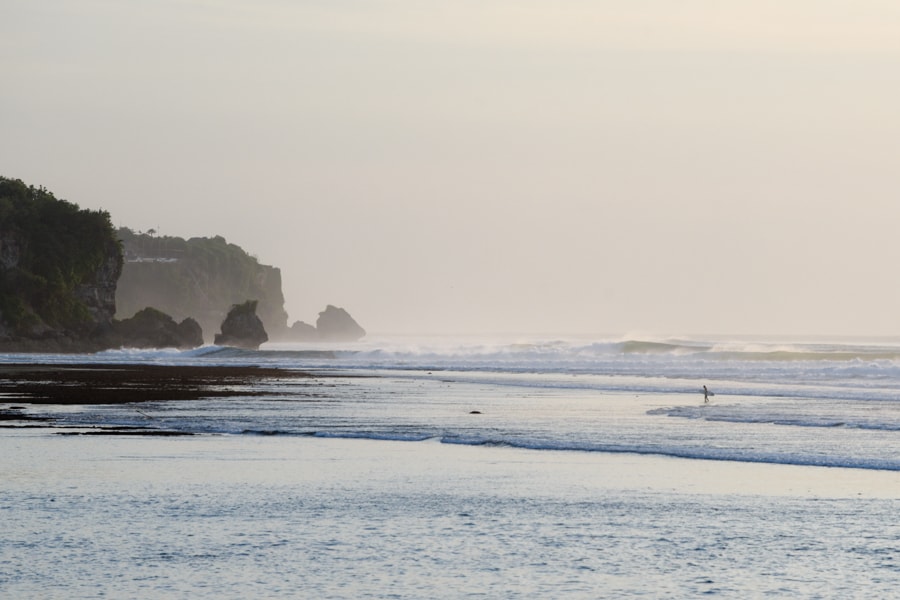
Yes, surfing in Bali is just as safe as surfing in other parts of the world. The same safety fundamentals apply to Bali as everywhere else: respect the ocean, know your limits, and be realistic about your surf abilities.
While Bali is known for powerful expert-level waves, there are plenty of intermediate and beginner surf spots as well. And at the end of the day it all comes down to the current ocean conditions and swell, as the ocean is continually changing – so what might be a good surf spot for beginners one day could be a terrible option the next day. It all depends on the current conditions. A good surf guide or surf instructor will know where to take you surfing depending on your experience level.
If you’re a beginner, we highly recommend taking surf lessons to develop a solid foundation and some general knowledge about the ocean before continuing your surfing journey on your own. This way you will have the hands-on guidance of an instructor and start to learn how to surf as safely as possible.
There are plenty of great beginner surf spots in Bali. In Canggu, both Batu Bolong (AKA Old Man’s) and Echo Beach are great options (when there is a small swell). On the Bukit Peninsula when swell isn’t big, the top surf spots for beginners are Dreamland and Padang Padang Right (AKA ‘Baby Padang’… not to be confused with proper Padang Padang, AKA Balinese Pipeline).
The best intermediate surf spots in Bali really depend on the swell and ocean conditions, but a few that are typically favorable to intermediates are: Balangan, the breaks in Canggu, Dreamland, and Playgrounds (in Nusa Lembongan) to name a few. You can read more about the best Bali surf spots here.
Bali has year-round surf, so the best time to surf in Bali depends on what waves you most want to surf, as different breaks and parts of the island light up in different seasons. May to September is Bali’s cooler dry season which is the best time for Bali’s west coast. The west coast has some of the islands most notable breaks on the Bukit Peninsula (Uluwatu, Padang Padang, etc.) and Canggu area. Roughly November to March is Bali’s wet season which brings the best conditions to the east coast breaks like Keramas and Sanur.
If you’re a beginner, any time of year is a good time to surf Bali, but we recommend the dry and shoulder seasons to avoid the rainy season.
The highest tourism season in Bali is July and August, and around Christmas and New Years, so crowds and prices are highest at this time. You can learn more about surfing Bali here.
Technically, yes, there are sharks in Bali. But there’s no need to be worried about sharks in Bali, as the vast majority are only small reef sharks which are typically shy and harmless. Since 1990 there have only been five shark attacks in Bali, none of which were fatal, and they all happened at a river mouth surf break located far away from the top surf hubs.
While it’s understandable to be fearful of sharks due to the media’s obsession with shark attacks and a certain 1970s blockbuster (thanks Jaws), it’s helpful to consider facts and hard statistics when it comes to shark attacks.
What do cows, deer, vending machines, and ladders have in common? They are just a few things that kill more people than sharks each year. Sharks are responsible for an average of ten fatalities per year worldwide. That’s ten deaths a year – compared to eight deaths every day (that’s 2,920 a year) from people texting while driving in the US alone. So yes, there are sharks in Bali, but no, you don’t have to worry about it as you’re more likely to get hurt a thousand other ways.
While there are a handful of different surf hubs in Bali, the two most popular places to stay in Bali for surfing are the Bukit Peninsula (Uluwatu area) and Canggu area. The Bukit Peninsula is home to some of the most famous breaks in Bali like Uluwatu and Padang Padang, and Canggu is full of beach break peaks and a good option for beginner and intermediate surfers. Vibe-wise, the Bukit Peninsula offers a more quiet country/remote feel, while Canggu is a much busier area with a lot more development, action, shops, and restaurants.
It depends. If you have your own equipment, then surfing Bali is virtually free, as it’s a free activity (although sometimes there is a small fee to park at some beaches and surf spots). Here are some other surf-related costs in Bali:
– Surfboard rental: $5 – $20 (rentals can be hourly or daily)
– Surf lesson: $12 – $50 per lesson
– Boat charter: $150 – $300+ per night (for multi-day trips), $50 – $150 per day (for day trips)
– Surf camps: $30 – $200 per night (pricing varies greatly depending on the accommodation, lessons, and what’s all included)
If you’re wondering about your overall travel costs for a surf trip to Bali, here’s a range of surf trip costs for different budgets:
– Low: $40 – $100 per day
– Mid-Range: $100 – $200 per day
– Luxury: $200 – $400+
Price ranges for traveling in Bali can vary greatly depending on a number of factors like how many people you’re traveling with, your accommodation, and overall travel style. If you’re traveling Bali on a low budget, you can keep costs down by staying in hostels and eating at local restaurants. If you have a mid- to high-range budget, there are stunning accommodations and fantastic restaurants to enjoy in Bali.
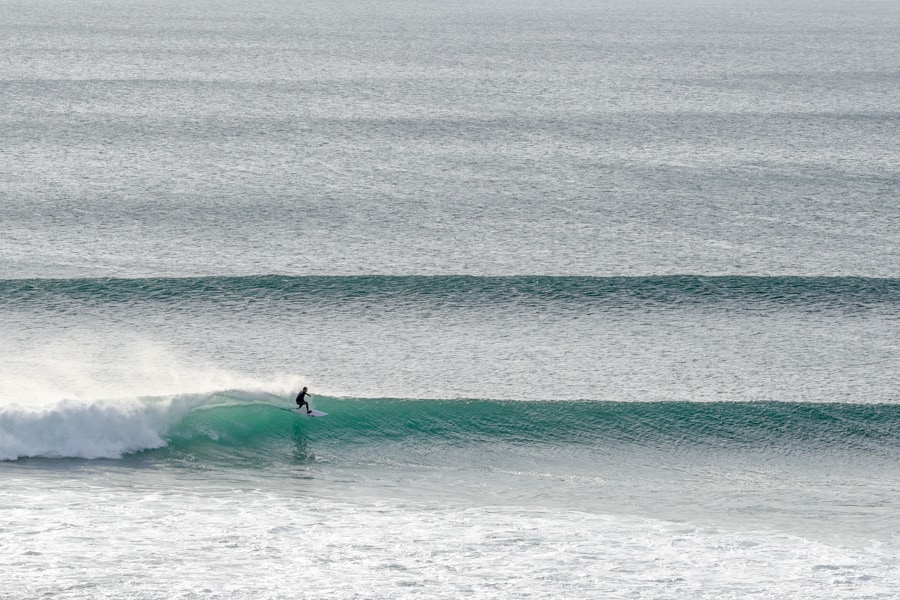
We hope this Guide to Surfing Bali will help you start planning and ultimately make that Bali surf trip a reality. Last but not least, be sure to check out our ultimate Surf Trip Packing List for a full breakdown of everything you might want to take on your trip.




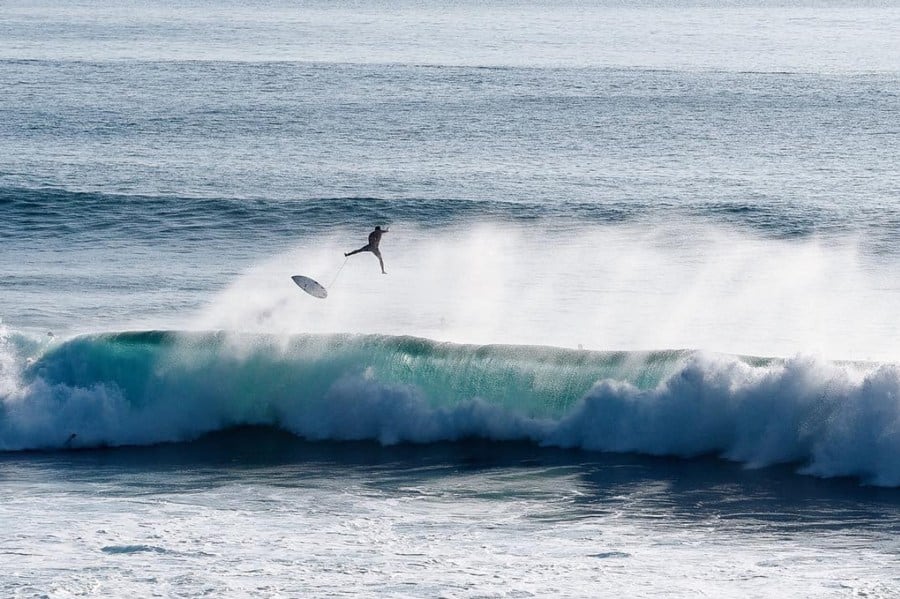



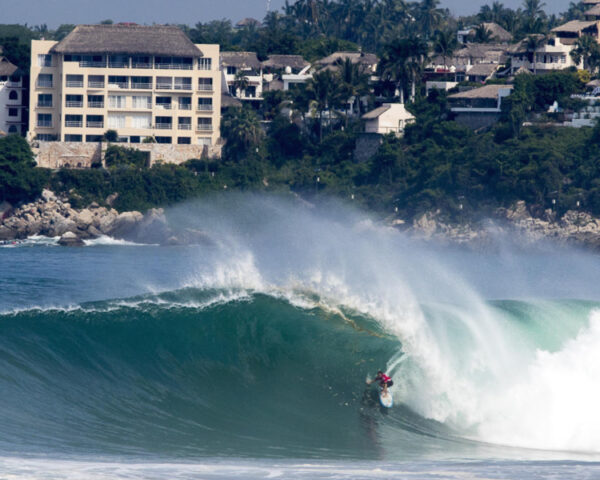
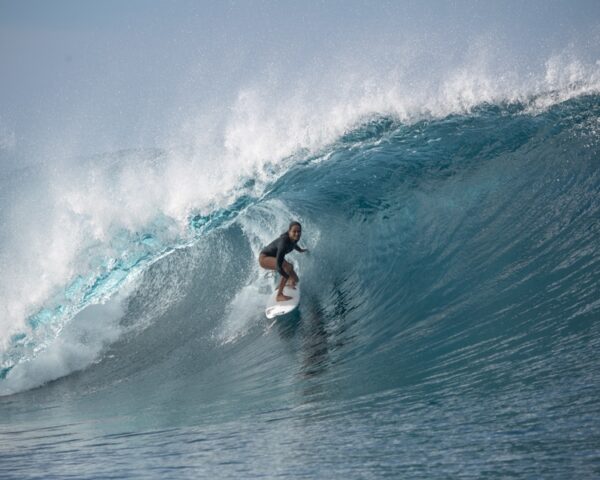
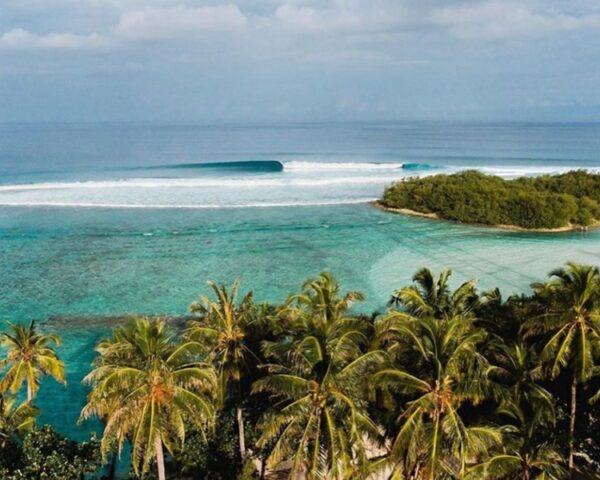

Brilliant summary – just what I was looking for. Thank you!
Wonderful! You’re very welcome 🙂
Thanks Guys
It took me a while to find you, but so glad I did, you have the best review/report on surfing Indonesia that I have found.
Regards Wayne
Thanks for stopping by, Wayne, and for the nice feedback. Glad you found Lush Palm to be a helpful resource! We’ll see ya around, cheers
Would you recommend this as a place for beginner surfing lessons? My pre-teen daughter and I would like to try but have no idea where to start, and I’m wondering if adding this onto an upcoming trip would be a good idea. Thanks!
Hey Jude, yeah, Bali is a great place for beginners to learn to surf. While Bali is known for having epic waves that cater to more advanced surfers, there are plenty of surf camps and surf breaks that are more mellow for beginners to learn to surf too. So no worries! You and your daughter would have an amazing time learning to surf in Bali! Enjoy!
Eric,
How crowded is Uluwatu during the shoulder season? I usually surf San Diego.
During high season how crowded is Uluwatu?
It can get pretty darn crowded depending on what you’re used to. Probably anywhere between 20-50+ surfers in the water trying to surf the same peak depending on the conditions, tides, etc.
Thank you for creating this guide! It was super helpful in planning our surf trip to Bali.
Our pleasure Warren! Stoked you found it helpful for your trip. Hope you have a great one and score!
Great guide, hope we can get included in the Surf resort for the 2020 version with our surf resort in Bingin.
Hi, could I also get your driver recommendation? Cheers!
Hey Alex – I just sent you an email with his info! Cheers
Hi Eric! Wonderful article and very informative. I’ll be in Sanur next week and was wondering if there are any beginner/intermediate surf spots and surf shops/rental nearby? Could you recommend the best way to get to these spots if travelling alone?
Hi Jimmy! Thanks. Hope I’m catching you in time. Some of the best beginner spots can be found at Canggu, Padang Padang Right (a soft inside right), Balangan and Dreamland which are all on the other side of the coast. As for intermediate spots, in my experience, places like Uluwatu, Impossibles, and many other breaks can be alright for an experienced intermediate surfer on the right day (smaller swells) and tides (usually a mid to higher tide). The east side of Bali is riddled with breaks that cater to upper-level intermediates to advanced/expert surfers. There are lots of strong currents to navigate and very shallow and dry reefs to watch out for. A scooter is a great way to get around, but I would strongly suggest you seek out an experienced local guide or surf camp so you could pick up valuable insights that could make all the difference before going it alone.
Hi. Can you recommend a driver for the whole day, I want hire hire one for full 5 days.
Hi Sean, yeah, we have a recommendation for you. I just sent you an email with more info.
Cheers!
Great post. It is very informative post for everyone I love reading this information. This is a perfect blog about bali camp. Keep posting and keep sharing like this.
Any suggestions for a surf guide to take us around.
Thank you
Hi Thomas, thanks for reaching out. We don’t have any personally vetted recommendations at the moment, however, we will be establishing a trusted network of surf guides to recommend in the future.
Hi guys,
Thanks for the wonderful guide! What would you recommend as a good beach/break for intermediate/beginner surfers that doesn’t get too crowded?
Hi Seth, our pleasure! Check out Balangan for sure. It can get busy but usually not too crowded. There are warungs/cafes right on the beach and the waves are typically pretty mellow there. Impossibles is a fun wave for intermediate level surfers on smaller days, but there is not much of a beach unless you go around the corner to Bingin which is only a few hundred yards south. Best to hit on a mid to lower tide. Hope you score some fun ones! Enjoy your trip!
Hello guys, love your page congrats, i was wondering if you know a cheap/good place to stay in lembongan near the waves, thank you and all the best!
Hi Carmelina, Thanks for your kind words! So happy you’re enjoying the site! In Nusa Lembongan, most of the surf breaks are pretty far offshore (like Lacerations and Shipwrecks), so many people take boats out, or from Jungutbatu Beach (the Main Beach) it’s about a 20-minute paddle. ‘Playgrounds’ is one of the easiest breaks to access because it’s closest to shore and it’s also one of the most user-friendly breaks. Not sure how cheap you’re looking for, but Song Lambung Beach Huts and Lembongan Cliff Villas are as close as you can get to Playgrounds, are nice hotels, and start at around $50 USD per night. If you’re looking for cheaper, Mojosurf Camp Nusa Lembongan has dorms for around $15 USD per night. Hope you have a great trip! Happy travels!
Great article. I definitely got a lot from reading this. Thanks for sharing! Heading to Bali for a week and looking to get barreled. Sounds a lot like Thailand and I love how you itemized the daily costs, but also provided insight on the reef. I’ll surely bring booties for the trip.
Awesome, our pleasure, thanks! Glad you found the article to be helpful. Have fun in Bali, it’s a magical place and there definitely plenty of barrels to seek out. Good luck and safe travels!
Great info on surfing in Bali! I’m headed there in June with my girlfriend who charges and we got some great advice from Eric.
Thanks Greg, glad we could help! How was Bali?!